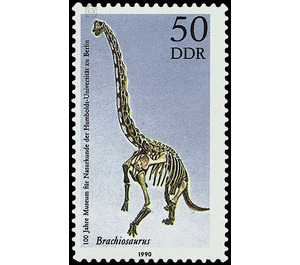100 years Museum for Naturopathy of the Humboldt University Berlin - Germany / German Democratic Republic 1990 - 50 Pfennig
Theme: Animals
| Country | Germany / German Democratic Republic |
| Issue Date | 1990 |
| Face Value | 50.00 |
| Color | grey |
| Perforation | K 12 1/2: 13 |
| Printing Type | offset |
| Stamp Type | Postage stamp |
| Item Type | Stamp |
| Chronological Issue Number | 3069 |
| Chronological Chapter | GER-DDR |
| SID | 33793 |
| In 15 Wishlists | |
100 Years Museum of Natural History Berlin On the occasion of the 100th anniversary of the Museum of Natural History of the Humboldt University in Berlin, the Ministry of Posts and Telecommunications of the German Democratic Republic issues five multicolored special postage stamps and a miniature sheet. Special Stamps from April 17 to June 16, 1990 100 Years Museum of Natural History Berlin In 1890, the natural history collections of the University of Berlin, combined in the Museum of Natural History, began to make their exhibition rooms accessible to the public in the then newly constructed building. On the special postage stamp series issued for this occasion, some of the dinosaur finds from the Tendaguru strata of East Africa are shown, which also contributed to the attractiveness and the international reputation of the museum. From 1909 to 1912, an expedition of the museum was able to carry out very successful excavations, to whose finds the dinosaur skeletons depicted belong. Dinosaurs have been the dominant animal group on Earth for more than 150 million years. In the Jurassic and Cretaceous periods, their development with giant shapes reached a climax. 50 Pfennig value: Brachiosaurus brancai JANENSCH, 1914 The skeleton of the Brachiosaurus is 13 m high and 23 m long, the largest dinosaur skeleton erected in a museum in the world. This giant belonging to the group of the Saurischian is also one of the largest terrestrial vertebrates in the history of the earth. Characteristic are the extended forelimbs ("Armsaurier"). Many questions about the way of life of this animal can not be answered yet. The denture identifies him as an herbivore. His live weight could have reached about 30 to 50 t. Brachiosaurus is also known from North America and Europe. This shows that at that time there must have been connections between these continents.


